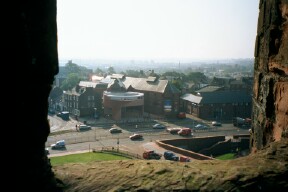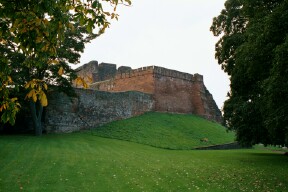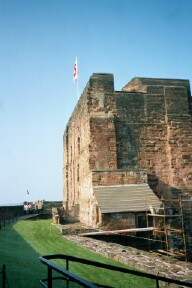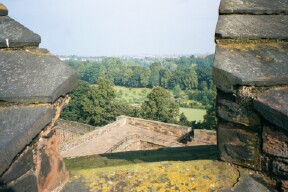Carlisle
September 26, 2001
We met Dr. Bruce Irving and drove with him to Carlisle Castle and tried to imagine what it was like in the 1500s during the height of the Border Reivers' activities. This area on the River Eden has long been considered an important one to fortify against Scots making forays south into England. The earliest fortifications on this site date from the 1st century as the Romans kept a garrison for some 300 years at this place they called
Luguvalium. Apparently the Roman fort and town were still standing when St. Cuthbert, bishop of Lindisfarne, visited Carlisle in 685. William II of England (William Rufus) built the 1st timber castle at Carlisle in 1092. His brother Henry I had a castle and towers built of stone beginning in 1122.
Along with northern counties of England, Carlisle became part of Scotland during the reign of Scotland's Kind David I with the castle keep and city walls being completed during this time period. David died at Carlisle in 1154 and his son, Malcolm IV (The Maiden), lost Carlisle and this region in 1157 to the English King Henry II. With the castle now back in English hands, it played a powerful role in subsequent wars, both Anglo-Scottish and Civil. As headquarters of the English Warden of the West March and as a fortress prison it figures in tales of the Reivers of the West March.
One of the most famous tales is that of the rescue of Kinmont Willie Armstrong from Carlisle Castle prison the night of April 13, 1596, by a varied group of Armstrongs, Grahams, Scotts, et al, led by Walter Scott of Buccleugh who also happened to be the Warden of the Scottish Middle March. It is said that several Irvines/Irvings also took part in this famous rescue.
After a climb to the battlements of the Keep, we walked through a new underground walkway from the castle to Tully House Museum. This walkway is paved with blocks of stone that bear the names of the famous "Riding/Reiving" families including Irving, Irvine, and Glendenning. There is also a boulder upon which is printed the famous "Monition of Cursing" of the Archbishop of Glasgow.
The days of the reivers were numbered when King James VI of Scotland succeeded Elizabeth I in 1603, a time called the "union of the crowns." James was especially harsh on members of reiving families, hanging some without benefit of trial, shipping many off to Ulster plantation in Ireland and ultimately dispersing them to American colonies. Many Scots-Irish-Americans have roots that go back to this time and place.
Tully House Museum has excellent displays ranging from stone-age to Roman to an excellent audio-visual program on the life and times of the Reivers.

After lunch we headed north to the Annandale Museum in Annan where Bruce showed us an interesting display on the sandstone industry and its history in Dumfriesshire. We learned that lower Annandale and the valley of the Kirtle Water are underlain with a bed of New Red Triassic Sandstone formed in water and termed 'water lain' and that this newly-quarried sandstone is soft and much favored by sculptors because it is fine grained and takes a smooth finish. When it hardens it becomes strong and weather resistant. Nithsdale and Upper Annandale have New Red Permian Sandstone that is termed 'dune bedded' because it was formed under different drier conditions. There are also other colors of building sandstone in this area. We also learned that many buildings in Dumfries, Annan, and Lockerbie as well as Sweetheart Abbey and Caerlaverock have been built with the sandstone and that the Corsehill Quarry supplied the beautiful red sandstone used in Albany, New York to make the "Million-dollar" staircase in the New York State Capitol building.
After viewing the exhibit we found ourselves speculating as to the origin of the sandstone used in construction of the many buildings, monuments and castles we saw.



